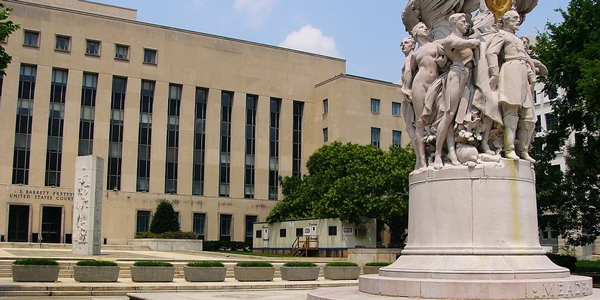By Rory D. Sweeney
FERC sufficiently justified its decision to revise how PJM allocates revenues from transmission congestion and its subsequent move to reject requests to rehear the issue, the D.C. Circuit Court of Appeals ruled Tuesday (17-1101).
Several PJM stakeholders had petitioned the court to overturn FERC’s January 2017 order that upheld a September 2016 ruling that modeling assumptions the RTO adopted to address financial transmission rights revenue inadequacy had resulted in unwarranted cost shifts between auction revenue rights holders and FTR holders.

The D.C. Circuit Court meets in the E. Barrett Prettyman Federal Courthouse | HSU Builders
FERC had also accepted PJM’s compliance filing in response to a requirement that it develop a method for allocating ARRs that doesn’t consider extinct generators (EL16-6). (See FERC Accepts PJM’s FTR Plan, Rejects Rehearing Requests.)
The petitioners included Old Dominion Electric Cooperative, American Municipal Power, PJM’s Independent Market Monitor, the New Jersey Board of Public Utilities and the Delaware Public Service Commission. PJM and several stakeholders involved in its FTR markets intervened, including Exelon, Elliott Bay Energy Trading, several Public Service Enterprise Group companies, Appian Way Energy Partners, NRG Power Marketing, DC Energy, Boston Energy Trading and Marketing, Vitol and J. Aron & Co.
The court noted in its decision that between 2010 and 2014, PJM could only fund between 69 and 85% of the prevailing-flow FTRs, so FTR payments were reduced pro rata. That, in turn, reduced the value of ARRs because FTRs were worth less at auction.
PJM’s stakeholders were unable to find consensus on how to address the issue, so the RTO asked FERC to settle it by declaring the current market design unjust and unreasonable. FERC held a technical conference in 2016 and granted PJM’s request, ordering several design modifications. After FERC rejected a request for rehearing, the petitioners appealed the decision to the D.C. Circuit.
The court sided with FERC on all three of the petitioner’s challenges. It ruled that excluding balancing congestion from the funding formula for FTRs was reasonable because including it “reduces the efficacy of FTRs as a hedge.” FERC was also reasonable in requiring the entire market, rather than FTR holders, to bear the costs of the congestion because “FTR holders do not cause and cannot predict the level of balancing congestion” and “are not the sole beneficiaries of balancing congestion,” the court said.
Additionally, the court decided petitioners provided no support for their view that FERC’s actions might endanger FTRs’ exemption at the Commodity Futures Trading Commission.
FERC’s rationale for continuing to net prevailing-flow and counterflow FTRs was also sufficient, the court said. The commission had doubted that “the elimination of netting would improve FTR funding” because that would simply “reallocate FTR revenue inadequacy among various market participants without actually addressing the fundamental issues associated with FTR revenue inadequacy.” The commission also reasoned that netting is “the functional equivalent of applying the same payout ratio to both prevailing-flow and counterflow FTRs,” so all FTRs are treated equally.
Finally, the court rejected the argument that FERC should not have eliminated outdated transmission paths from the formula used to allocate ARRs. While petitioners instead wanted FERC to artificially increase growth forecasts, the commission “adequately explained why it preferred to rectify the root cause of the problem rather than pursue a remedy that could distort the planning process, such that transmission planning is not based on expected system conditions,” the court said.
The court also said it saw “no cause to displace FERC’s considered policy judgment on this matter.”


